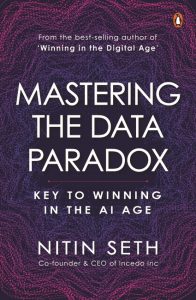Today’s data-driven world is changing in the blink of an eye. Boundaries blur, expectations evolve, and innovation knows no limits. In Mastering the Data Paradox by Nitin Seth, understand the convergence of data and AI, and explore how organizations leverage these forces to redefine industries and exceed customer expectations.

***
Blurring of boundaries and expectations.
As a result of continuously evolving customer expectations as well as the business and competitor landscape, organizations are now becoming more fluid, and are moving towards becoming a one-stop solution to customer requirements. Using data and technologies, they can stretch beyond their own area of expertise to integrate multiple solutions under one hood. Today a mobile service provider is not just providing connectivity solutions, but are also providing payments, shopping, gaming, entertainment and many other solutions as well.
The Amazonification of services and Netflixization of experiences has not only affected their own respective industries but has transformed cross-industry expectations. Today, personalized experiences have gone beyond the purview of the retail industry. Equipped with access to data, B2B customers are also expecting a similar kind of personalization from chemical manufacturers. For example, the ‘Lab Assistant’ at BASF, is a web-based application that provides full access to data on complete product data and exclusive formulations that enable customers to find the right raw material and formulation ideas to create customized product formulations. Similarly, omnichannel experiences are not just expected from entertainment providers today but also from insurance providers. Now insurance is available to be bought online, over phone or in-store. Customers not only expect the convenience of buying online, but also similar levels of efficiency and convenience as top tier e-commerce sites. And since insurance purchases are highly personal and have many considerations, customers prefer multiple touchpoints before finalizing a purchase.
In addition to that, we have increasingly come to expect one-stop shop solutions stemming from Amazon-like business models that we have got used to. So, we expect even our financial services provider to provide us with an array of services under one roof. Today, in a world where customers have a wide range of options to choose from, they are ready to pay a premium for ease of use or access. They would prefer interacting with a single service provider who can cater to
different customer requirements, like savings, investment, insurance, bill payments, loans or even shopping, and deliver desired customer experience. We have come to expect our financial partner to provide connected seamless services across all these offerings, available at our disposal through a single app or website, accessible through least number of clicks, with minimal documentation and shortest lead time. Today, a car loan or a home loan, is available pre-approved by
your financial service provider, can be availed via the bank website or mobile app with just a few clicks and the money is transferred within a few hours or a day or two.
That is the amazing feat that data has enabled individuals and organizations to achieve. And like I said, this is just the beginning. It’s just the tip of the iceberg. Can you imagine what we can accomplish if we are able to go deeper and unleash the full potential of data?
Key takeaways
• Data fuels digital technologies, enabling unprecedented applications. Digital technologies, in return, spawn more data, adding to the data explosion, further enabling widespread AI use. And AI is enhancing digital experiences and data itself. This recursive relation between digital, data and AI is one of the most powerful transformative forces in the world today.
• The omnipresence of data has catalysed a comprehensive transformation across every aspect of our life, so much so that we now find ourselves unable to envision life without digital technologies fuelled by data.
• The evolving lifestyles are opening massive opportunities for businesses across all industries. Abundance of customer data has enabled firms to deliver Amazon-like services and Netflix-like experiences. Organizations are now able to extract untapped value and innovate like never before.
• The interplay between individuals and industries is redefining industry landscapes, blurring industry boundaries and transforming cross-industry expectations.
***
Get your copy of Mastering the Data Paradox by Nitin Seth wherever books are sold








